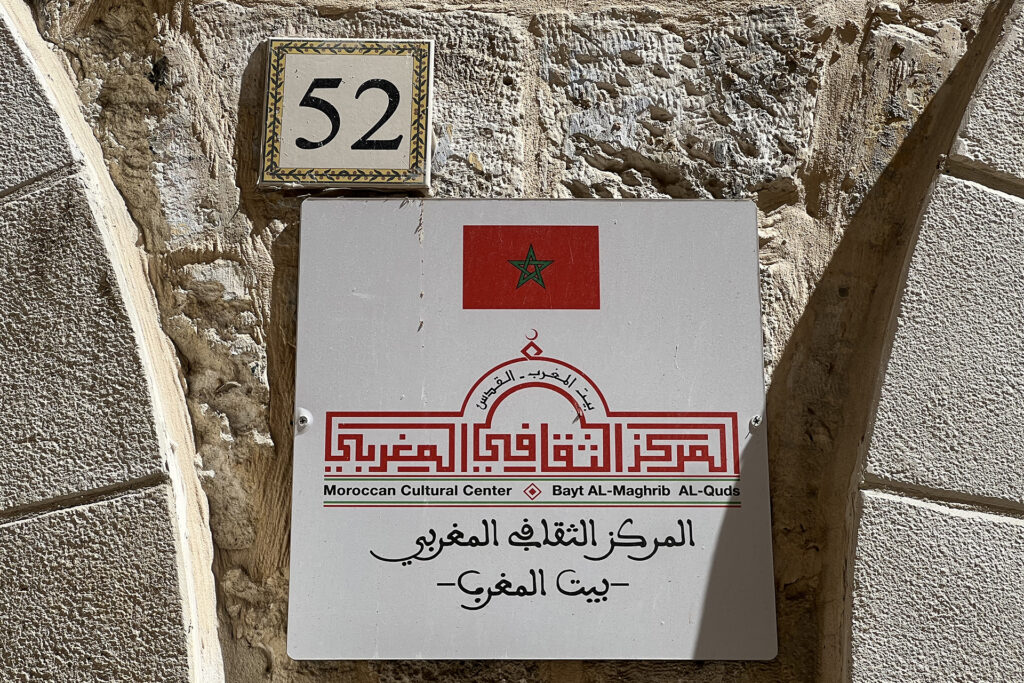Morocco House is an archaeological, historical and cultural landmark located in the heart of the Old City of Jerusalem. It is a historical property located a few meters from Al-Aqsa Mosque.
It was previously part of the Naqshbandi Bukhari zawiya complex. It was acquired by the Bayt Mal Al-Quds Agency from a Jerusalemite family with funding from the Kingdom of Morocco during the reign of the late King Hassan II, and it underwent restoration and rehabilitation during the reign of King Mohammed VI.
The building was transformed into a cultural center that displays the history of the Moroccan component in Jerusalem and strengthens close relations between Moroccans and Palestinians. It is considered the first Moroccan cultural center in Jerusalem and the largest Arab cultural center in Palestine that combines the Moroccan character with local architecture.
the site
The Maghrib House is located in the heart of Old Jerusalem, at the crossroads of the Via Dolorosa and Bab al-Ghawanimah Road. It is one of the gates of the Al-Aqsa Mosque. It was given this name in reference to Ghanem bin Ali, who descends from a Moroccan family that came to Palestine from the Ghamara region located between the cities of Tangier and Tetouan in the year 558 AH, during the time of al-Nasser. Salah al-Din al-Ayyubi.
The “Morocco House” Center – which extends over an area of 3,000 square meters distributed over 3 floors – was built on top of the original stones on which ancient Jerusalem was built, and its history dates back to before the Byzantine and Roman eras. It stands in the middle of many Sufi corners and the most important churches and Christian monuments. Steps away from the blessed Al-Aqsa Mosque.
The Moroccan House or the Moroccan Cultural Center is located at the entrance to the Via Dolorosa, which is considered a sacred path for all Christians in the world. It is located specifically in the heart of the second station of the Via Dolorosa, where Christians believe that the soldiers carried the cross to Jesus Christ. The building is less than 50 meters from the place. The first stop, which starts from the headquarters of Governor Titus, who Christians say issued the crucifixion sentence on Jesus Christ, and most historians believe that this headquarters was located somewhere in the spot on which the Omariya School is now located, adjacent to the Moroccan Cultural Center.
Choosing the location of the Moroccan Cultural Center has a deep social and religious meaning, as it is a symbol of the meanings of Islamic-Christian brotherhood, according to those in charge of it.

The story of the building
The story of the Kingdom of Morocco’s possession of this historic property began in 1998 when Palestinian leader Faisal Al-Husseini proposed the matter to King Hassan II during one of his visits to Morocco.
The late king accepted the idea and issued instructions to purchase the property from a Jerusalemite family, to strengthen the Moroccan presence in this archaeological site that attracts thousands of Christians around the world.
In 2008, the Bayt Mal Al-Quds Agency, under instructions from King Mohammed VI, began the restoration of the building after completing the technical studies that were assigned to an engineering consulting office that includes Palestinian and Moroccan engineers.
This process took enough time, and then culminated in 2016 with the Moroccan character of some aspects of the building, in complete harmony with local architecture.
The cost of purchasing the building amounted to about $5 million, to which a budget of $3 million was added that covered restoration and equipment operations, so that it would be ready to embrace the creativity and activities of Moroccan and Palestinian artists and creators, among others.
Moroccan house facilities
The visitor to this center receives an entrance decorated with engraved wooden doors. The building consists of several facilities, including the Saqia El Hamra space, which includes a permanent exhibition of fine arts by Moroccan and Palestinian artists.
To its right is the Morocco House Museum with its caves and catacombs, and to the left is the glass bridge overlooking a cave whose sides include “mother” stones that testify to the history of this place, its antiquity, and its historical value.
The center also includes a main salon furnished in the traditional Moroccan style with carpets woven by Moroccan hands, and it forms a quiet space for visitors to the library corridor, which is located in front of the salon and combines the pleasure of reading and drinking Moroccan tea.
Not far from the library – which includes about 5,000 titles of works on thought, literature, jurisprudence, history, science, philosophy, and others – there is the Dar es Salaam space, which is decorated with artistic paintings made of Moroccan terracotta (mosaic) and carved wood, and in which lectures and cultural forums are organized.
On the second floor of the building, there are many halls and large spaces bearing historical Moroccan names such as Tangis, Volubilis, Angad and Zayan. These halls were equipped with the latest electronic equipment and audio-visual equipment for organizing cultural and artistic events. They are halls that are acoustically isolated from the outside.
As for the third floor, it includes the administrative offices of the Moroccan Cultural Center, which were equipped according to the modern and practical style of offices, and to its right extends an outdoor space opposite the minaret of Bab Al-Ghawanmeh, which was built in the Mamluk era, and in the middle there are traditional fountains made of tiles in imitation of old houses in Morocco, and it forms a cultural café with a beautiful view. It is where art and literature enthusiasts and connoisseurs of authentic Moroccan cooking meet.
The Arc of Triumph or Okohomo Arch extends from the building, which connects the Maghrib House to the neighboring Church of the Sisters of Zion, extending along the Via Dolorosa.

